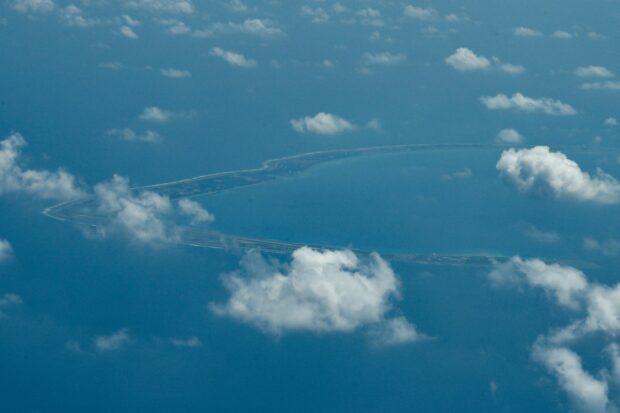MANILA, Philippines — The Philippine Navy has spotted about 15 to 25 warships near Panganiban (Mischief) Reef, some 37 kilometers southeast of Ayungin (Second Thomas) Shoal where a grounded World War II-era warship serves as a Philippine outpost.
Commodore Roy Vincent Trinidad, the newly appointed Navy spokesperson for the West Philippine Sea (WPS), also said about 200 Chinese maritime militia vessels, including 10 to 15 China Coast Guard (CCG) ships, were also spotted in the West Philippine Sea.
This is higher than the figure cited by US maritime expert Ray Powell, when he said last week that China has deployed at least 50 maritime militia ships at Panganiban ahead of another resupply mission to Ayungin Shoal.
‘Consistent’ presence
China seized control of Panganiban Reef in 1995 and has since developed it into a military base.
Chinese warships were spotted around Ayungin in November and December last year, but only two to five were seen at that time.
Then early this month, two Chinese Navy warships were seen already within the waters of western Luzon, as they shadowed Philippine and US Navy warships conducting drills off Cabra Island in Occidental Mindoro.
“Every now and then they get deployed all over the South China Sea,” Trinidad said at a press briefing in Camp Aguinaldo on Tuesday. “So a lot of these are under the [Chinese Navy’s] South Sea Fleet. It’s their gray ships.”
He noted, however, that their presence is “really not alarming in terms of the numbers,” adding that the number of Chinese ships deployed to Philippine waters has been “consistent throughout the past years.”
He also said: “It is difficult to give you the exact number [of Chinese ships] at an exact point of time.”
“[F]or the warships and the coast guard vessels, over the past, I would say, 8 to 10 years, the number has been fairly constant,” he said of the 15 to 25 warships and 10 to 15 CCG ships now seen at Panganiban.
Trinidad said “the escalation in the numbers” of Chinese ships began with the deployment of more militia vessels.
“[W]hat we are really concerned about is their actions towards our own troops,” he said. “Of course, we will always look out for the welfare of troops on the contested waters.”
Chester Cabalza, president of Manila-based think tank International Development and Security Cooperation, said the Chinese Navy is known for its tortoise formation at sea.
“That means they always deploy their vessels and warships during peacetime… as a shield and first line of defense in times of conflict,” he told the Inquirer.
Cabalza suggested that the Navy and Coast Guard “should also deploy a stand-by Philippine armada to safeguard our islands and other maritime features.”
“It is just fair to maintain those floating and parked vessels in our own internal waters without doing any commotion to antagonize the Chinese Navy and militia,” he said.
“That’s the reason that we have to increase bigger and faster ships to counter any eventuality,” he added.
He explained that this was not to escalate tensions “but to stage a strong presence in our own maritime domains.”
‘Balikatan’ near Taiwan
Meanwhile, the Armed Forces of the Philippines announced a “bigger” joint exercise between Philippine and American troops scheduled in April.
This year’s “Balikatan” drills would have “more challenges” and “more complexity,” and would include training in cyberspace and information warfare, AFP spokesperson Col. Francel Margareth Padilla said in the same press briefing with Trinidad.
“Aside from kinetic activities and litoral airspace and land space, we will also be doing exercises in the nonphysical domain such as cyberspace and information warfare,” she added.
The locations for the joint drills have yet to be determined. But Northern Luzon Command chief Lt. Gen. Fernyl Buca said the AFP is considering the provincial capital of Basco in Batanes and uninhabited Mavulis, the northernmost of the Batanes islands which is some 250 km from Taiwan.
Beijing regards the self-governing island as a renegade province. Last year its embassy in Manila expressed its objection to the establishment of sites in northern Luzon under the Philippines’ Enhanced Defense Cooperation Agreement with the United States.
The AFP said on Monday it is considering the country’s islands facing Taiwan as potential sites for the Balikatan drills.
Airdrop of supplies
Padilla also said the airdrop of supplies to troops at Ayungin Shoal is now part of the AFP’s “operational mix.”
There had been suggestions since last year to deliver the supplies by air, but after repeated efforts by Chinese ships to block resupply missions to Philippine troops posted at the BRP Sierra Madre, the ship grounded at the shoal.
In August last year, the AFP’s Western Command said it was considering all options.
Padilla reiterated that position in a press briefing, but declined to elaborate on the details of the operation.
Nevertheless, the airborne mission has been accomplished, a senior military officer told defense reporters on condition of anonymity.
Trinidad also affirmed the government’s position that providing support by air or ship at Ayungin Shoal is “our constitutional mandate,” after China had claimed that its coast guard had not attempted to block the airdrop of supplies.
‘Necessary repairs’
The monthly rotation and resupply (Rore) mission by sea was last conducted in December.
A Rore mission scheduled on Jan. 20 and 21 was postponed because the resupply boat Unaizah Mae 1 needed repairs, Padilla said.
“The schedule for the next Rore will depend on the necessary repairs for the vessel to be deemed seaworthy,” she said.
